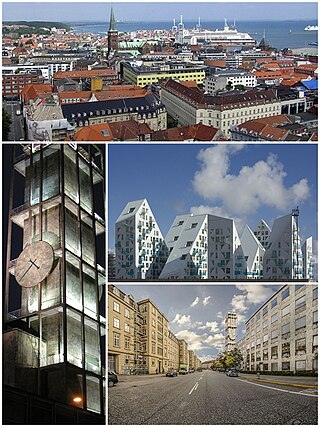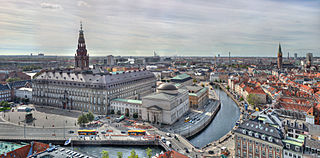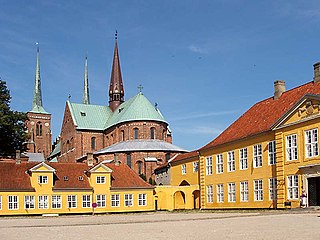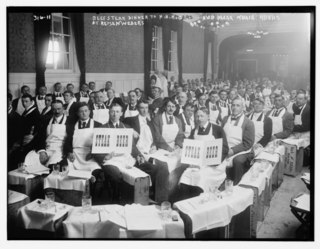
Aarhus is the second-largest city in Denmark and the seat of Aarhus Municipality. It is located on the eastern shore of Jutland in the Kattegat sea and approximately 187 kilometres (116 mi) northwest of Copenhagen.

Copenhagen is the capital and most populous city of Denmark, with a population of around 650,000 in the municipality and 1.4 million in the urban area. The city is on the islands of Zealand and Amager, separated from Malmö, Sweden, by the Øresund strait. The Øresund Bridge connects the two cities by rail and road.

Odense is the third largest city in Denmark and the largest city on the island of Funen. As of 1 January 2023, the city proper had a population of 182,387 while Odense Municipality had a population of 207,762, making it the fourth largest municipality in Denmark. Eurostat and OECD have used a definition for the Metropolitan area of Odense, which includes all municipalities in the Province of Funen, with a total population of 504,066 as of 1 July 2022

Nuuk is the capital of and most populous city in Greenland, an autonomous territory in the Kingdom of Denmark. Nuuk is the seat of government and the territory's largest cultural and economic center. The major cities from other countries closest to the capital are Iqaluit and St. John's in Canada and Reykjavík in Iceland. Nuuk contains a third of Greenland's population and its tallest building. Nuuk is also the seat of government for the Sermersooq municipality. In January 2023, it had a population of 19,604. Nuuk is considered a modernized city after the policy began in 1950.

Roskilde is a city 30 km (19 mi) west of Copenhagen on the Danish island of Zealand. With a population of 52,580, the city is a business and educational centre for the region and the 10th largest city in Denmark. It is governed by the administrative council of Roskilde Municipality.

Skagen is Denmark's northernmost town, on the east coast of the Skagen Odde peninsula in the far north of Jutland, part of Frederikshavn Municipality in Nordjylland, 41 kilometres (25 mi) north of Frederikshavn and 108 kilometres (67 mi) northeast of Aalborg. The Port of Skagen is Denmark's main fishing port and it also has a thriving tourist industry, attracting 2 million people annually.

The earliest traces of Danish music go back to the many twisting Bronze-Age horns or lurs which some experts have identified as musical instruments. They have been discovered in various parts of Scandinavia, mostly Denmark, since the end of the 18th century. Denmark's most famous classical composer is Carl Nielsen, especially remembered for his six symphonies, while the Royal Danish Ballet specializes in the work of Danish choreographer August Bournonville. Danes have distinguished themselves as jazz musicians, and the Copenhagen Jazz Festival has acquired an international reputation. The modern pop and rock scene has produced a few names of note, including MØ, Dizzy Mizz Lizzy, Lukas Graham, D-A-D, Tina Dico, Aqua, The Raveonettes, Michael Learns to Rock, Volbeat, Alphabeat, Safri Duo, Medina, Oh Land, Kashmir, King Diamond, Outlandish, and Mew. Lars Ulrich is the first Danish musician to be inducted into the Rock and Roll Hall of Fame.

Christiansborg Palace is a palace and government building on the islet of Slotsholmen in central Copenhagen, Denmark. It is the seat of the Danish Parliament, the Danish Prime Minister's Office, and the Supreme Court of Denmark. Also, several parts of the palace are used by the Danish monarch, including the Royal Reception Rooms, the Palace Chapel and the Royal Stables.

Legoland Windsor Resort, styled and also known as Legoland Windsor, is a theme park and resort in Windsor, Berkshire in England, themed around the Lego brand. The park opened on 17 March 1996 and is currently operated by Merlin Entertainments. The park's attractions consist of a mixture of Lego-themed rides, models, and building workshops targeted at children between three and twelve.

Assistens Cemetery in Copenhagen, Denmark, is the burial site of many Danish notables as well as an important greenspace in the Nørrebro district. Inaugurated in 1760, it was originally a burial site for the poor laid out to relieve the crowded graveyards inside the walled city, but during the Golden Age in the first half of the 19th century it became fashionable and many leading figures of the epoch, such as Hans Christian Andersen, Søren Kierkegaard, Christoffer Wilhelm Eckersberg, and Christen Købke are all buried here.

Cedar-Riverside, also referred to as the West Bank, or simply Riverside, is a neighborhood within Minneapolis, Minnesota. Its boundaries are the Mississippi River to the north and east, Interstate 94 to the south, and Hiawatha Avenue and Interstate 35W to the west. It has a longstanding tradition of cultural diversity and settlement, with a robust arts tradition.

An Australian pub or hotel is a public house or pub for short, in Australia, and is an establishment licensed to serve alcoholic drinks for consumption on the premises. They may also provide other services, such as entertainment, meals and basic accommodation.

The Coliseum of Porto is a Portuguese theatre and concert venue in the municipality of Porto, in northern Portugal, with a capacity for a standing audience of 4000. A leading venue for music and cultural events in Porto, together with Batalha Cinema, the Coliseu is an example of Portuguese Streamline Moderne and Art Deco styles in the city of Porto.

The Birmingham Gay Village is an LGBT district or "gaybourhood" next to the Chinese Quarter in Birmingham city centre, centred along Hurst Street, which hosts many LGBT-friendly businesses. The village is visited by thousands of people every week and has a thriving night life featuring clubs, sports bars, cocktail bars, cabaret bars and shops, with most featuring live entertainment including music, dancing and drag queens.

Aksel Jørgensen was a Danish painter and wood engraver. He is also remembered for his years as the director and professor at the Royal Danish Academy where he instructed many Danish illustrators.

Allégade is the oldest street in the Frederiksberg district of Copenhagen, Denmark. It runs from Frederiksberg Runddel to Frederiksberg Town Hall Square, along the east side of Frederiksberg Gardens, connecting Pile Allé to Falkoner Allé. The streetscape is, in spite of the central location, characterized by houses that are pulled back from the street with front gardens behind white fences. Several buildings are old country houses from the time when Frederiksberg was a summer destination outside Copenhagen. Along the northernmost part of the street, on its west side, is a narrow garden complex, Digterlunden with a statue of Holger Drachmann.

Terrific Street was a short-lived entertainment district on San Francisco's Barbary Coast during the early 20th century. It consisted of dance halls, jazz clubs, and various kinds of drinking establishments. Terrific Street was centered upon a single block of Pacific Street, which was one of the earliest streets to cut through the hills of San Francisco, starting near Portsmouth Square and continuing east to the first shipping docks at Buena Vista Cove. The district was located between Kearny and Montgomery streets on Pacific Street.

Josty is a historic restaurant venue situated inside Frederiksberg Gardens, off Pile Allé, in the Frederiksberg district of Copenhagen, Denmark. It is now mainly operated as an event venue but also has a small number of hotel rooms and operates a café on the Veranda facing the park in the summer time. The current building is from 1899 but the place traces its history back to a pastry café which opened at the site in 1824.

Roxy Theatre and Peters Greek Cafe Complex is a heritage-listed theatre and cafe at 74 Maitland Street, Bingara, Gwydir Shire, New South Wales, Australia. It was designed by Mark Woodforde with construction supervised by George Psaltis of the Greek partnership Peters and Co. in 1935-1936. It was added to the New South Wales State Heritage Register on 25 August 2017.

Reisenweber's Cafe, also known as Reisenweber's Restaurant or simply Reisenweber's, was a restaurant, nightclub, and hotel in Columbus Circle, Manhattan, on the intersection of Eighth Ave and 58th Street, from 1856/7 to 1922.

























